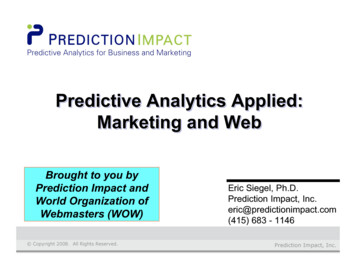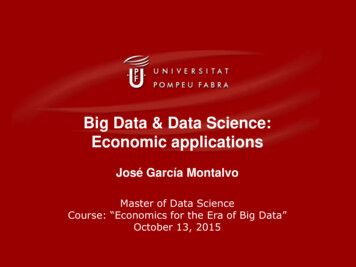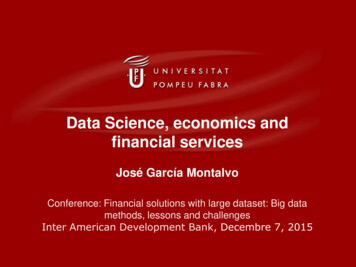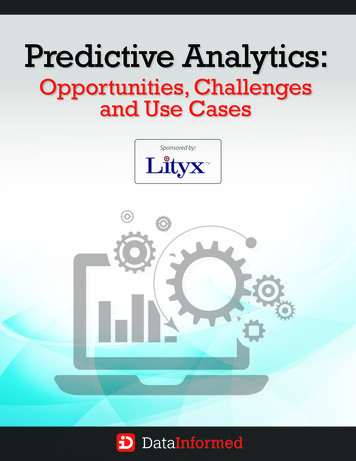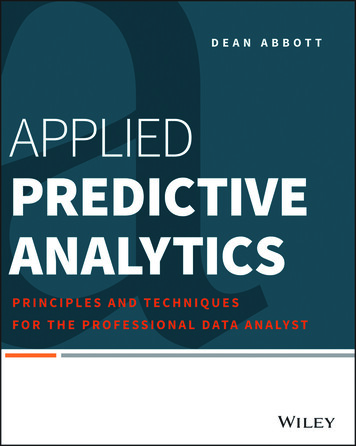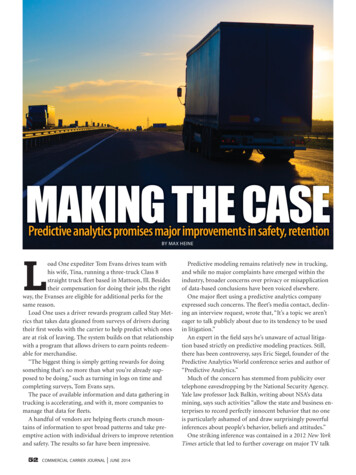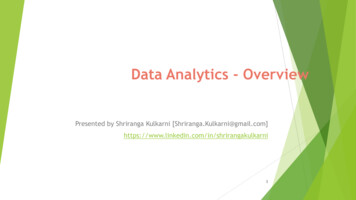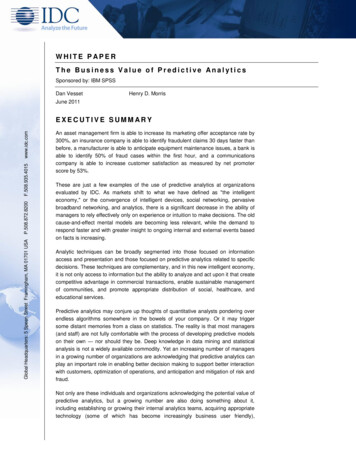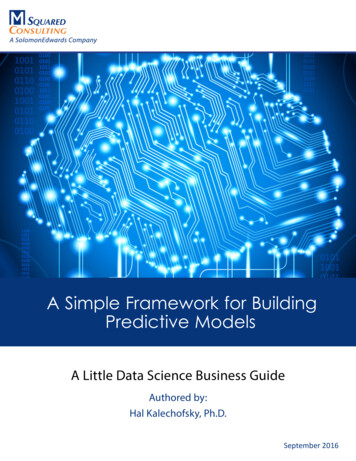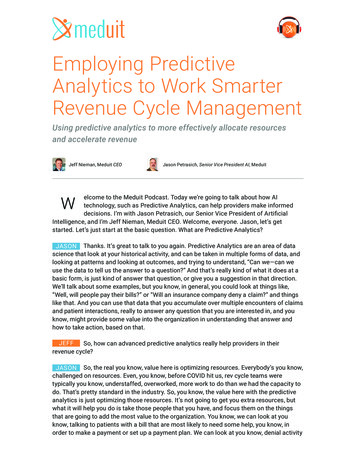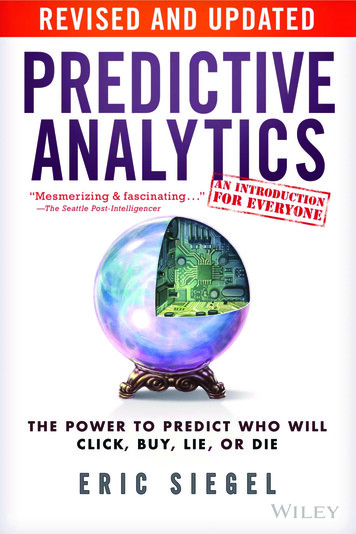
Transcription
3GFFIRS11/19/201510:1:4Page iPraise for Predictive Analytics“Littered with lively examples . . .”—The Financial Times“Readers will find this a mesmerizing and fascinating study. I know Idid! . . . I was entranced by the book.”—The Seattle Post-Intelligencer“Siegel is a capable and passionate spokesman with a compelling vision.”—Analytics Magazine“A must-read for the normal layperson.”—Journal of Marketing Analytics“This book is an operating manual for twenty-first-century life. Drawingpredictions from big data is at the heart of nearly everything, whether it’s inscience, business, finance, sports, or politics. And Eric Siegel is the idealguide.”—Stephen Baker, author, The Numerati and Final Jeopardy: The Storyof Watson, the Computer That Will Transform Our World“Simultaneously entertaining, informative, and nuanced. Siegel goes behindthe hype and makes the science exciting.”—Rayid Ghani, Chief Data Scientist,Obama for America 2012 Campaign“The most readable (for we laymen) ‘big data’ book I’ve come across. By far.Great vignettes/stories.”—Tom Peters, coauthor, In Search of Excellence“The future is right now—you’re living in it. Read this book to gainunderstanding of where we are and where we’re headed.”—Roger Craig, record-breaking analytical Jeopardy!champion; Data Scientist, Digital Reasoning
3GFFIRS11/19/201510:1:4Page ii“A clear and compelling explanation of the power of predictive analytics andhow it can transform companies and even industries.”—Anthony Goldbloom, founder and CEO, Kaggle.com“The definitive book of this industry has arrived. Dr. Siegel has achievedwhat few have even attempted: an accessible, captivating tome on predictiveanalytics that is a must-read for all interested in its potential—and peril.”—Mark Berry, VP, People Insights, ConAgra Foods“I’ve always been a passionate data geek, but I never thought it might bepossible to convey the excitement of data mining to a lay audience. That iswhat Eric Siegel does in this book. The stories range from inspiring todownright scary—read them and find out what we’ve been up to while youweren’t paying attention.”—Michael J. A. Berry, author of Data Mining Techniques, Third Edition“Eric Siegel is the Kevin Bacon of the predictive analytics world, organizingconferences where insiders trade knowledge and share recipes. Now, he hasthrown the doors open for you. Step in and explore how data scientists arerewriting the rules of business.”—Kaiser Fung, VP, Vimeo; author of Numbers Rule Your World“Written in a lively language, full of great quotes, real-world examples, andcase studies, it is a pleasure to read. The more technical audience will enjoychapters on The Ensemble Effect and uplift modeling—both very hot trends.I highly recommend this book!”—Gregory Piatetsky-Shapiro, Editor, KDnuggets;founder, KDD Conferences“Exciting and engaging—reads like a thriller! Predictive analytics has its rootsin people’s daily activities and, if successful, affects people’s actions. By way ofexamples, Siegel describes both the opportunities and the threats predictiveanalytics brings to the real world.”—Marianna Dizik, Statistician, Google
3GFFIRS11/19/201510:1:4Page iii“A fascinating page-turner about the most important new form of information technology.”—Emiliano Pasqualetti, CEO, DomainsBot Inc.“Succeeds where others have failed—by demystifying big data and providingreal-world examples of how organizations are leveraging the power ofpredictive analytics to drive measurable change.”—Jon Francis, Senior Data Scientist, Nike“In a fascinating series of examples, Siegel shows how companies have mademoney predicting what customers will do. Once you start reading, you willnot be able to put it down.”—Arthur Middleton Hughes, VP, Database Marketing Institute;author of Strategic Database Marketing, Fourth Edition“Excellent. Each chapter makes the complex comprehensible, making heavyuse of graphics to give depth and clarity. It gets you thinking about what elsemight be done with predictive analytics.”—Edward Nazarko, Client Technical Advisor, IBM“What is predictive analytics? This book gives a practical and up-to-dateanswer, adding new dimension to the topic and serving as an excellentreference.”—Ramendra K. Sahoo, Senior VP,Risk Management and Analytics, Citibank“Competing on information is no longer a luxury—it’s a matter of survival.Despite its successes, predictive analytics has penetrated only so far, relative toits potential. As a result, lessons and case studies such as those provided inSiegel’s book are in great demand.”—Boris Evelson, VP and Principal Analyst, Forrester Research“Fascinating and beautifully conveyed. Siegel is a leading thought leader inthe space—a must-have for your bookshelf!”—Sameer Chopra, Chief Analytics Officer, Orbitz Worldwide
3GFFIRS11/19/201510:1:4Page iv“A brilliant overview—strongly recommended to everyone curious aboutthe analytics field and its impact on our modern lives.”—Kerem Tomak, VP of Marketing Analytics, Macys.com“Eric explains the science behind predictive analytics, covering both theadvantages and the limitations of prediction. A must-read for everyone!”—Azhar Iqbal, VP and Econometrician,Wells Fargo Securities, LLC“Predictive Analytics delivers a ton of great examples across business sectors ofhow companies extract actionable, impactful insights from data. Both thenovice and the expert will find interest and learn something new.”—Chris Pouliot, Director, Algorithms and Analytics, Netflix“In this new world of big data, machine learning, and data scientists, EricSiegel brings deep understanding to deep analytics.”—Marc Parrish, VP, Membership, Barnes & Noble“A detailed outline for how we might tame the world’s unpredictability. Ericadvocates quite clearly how some choices are predictably more profitablethan others—and I agree!”—Dennis R. Mortensen, CEO of Visual Revenue,former Director of Data Insights at Yahoo!“This book is an invaluable contribution to predictive analytics. Eric’sexplanation of how to anticipate future events is thought provoking anda great read for everyone.”—Jean Paul Isson, Global VP Business Intelligence and PredictiveAnalytics, Monster Worldwide; coauthor, Win with Advanced BusinessAnalytics: Creating Business Value from Your Data“Predictive analytics is the key to unlocking new value at a previouslyunimaginable economic scale. In this book, Siegel explains how, doing anexcellent job to bridge theory and practice.”—Sergo Grigalashvili, VP of Information Technology,Crawford & Company
3GFFIRS11/19/201510:1:4Page v“Predictive analytics has been steeped in fear of the unknown. Eric Siegeldistinctively clarifies, removing the mystery and exposing its many benefits.”—Jane Kuberski, Engineering and Analytics,Nationwide Insurance“As predictive analytics moves from fashionable to mainstream, Siegelremoves the complexity and shows its power.”—Rajeeve Kaul, Senior VP, OfficeMax“Dr. Siegel humanizes predictive analytics. He blends analytical rigor withreal-life examples with an ease that is remarkable in his field. The book isinformative, fun, and easy to understand. I finished reading it in one sitting. Amust-read . . . not just for data scientists!”—Madhu Iyer, Marketing Statistician, Intuit“An engaging encyclopedia filled with real-world applications that shouldmotivate anyone still sitting on the sidelines to jump into predictive analyticswith both feet.”—Jared Waxman, Web Marketer at LegalZoom,previously at Adobe, Amazon, and Intuit“Siegel covers predictive analytics from start to finish, bringing it to life andleaving you wanting more.”—Brian Seeley, Manager, Risk Analytics, Paychex, Inc.“A wonderful look into the world of predictive analytics from the perspective of a true practitioner.”—Shawn Hushman, VP, Analytic Insights,Kelley Blue Book“A must—Predictive Analytics provides an amazing view of the analyticalmodels that predict and influence our lives on a daily basis. Siegel makes it abreeze to understand, for all readers.”—Zhou Yu, Online-to-Store Analyst, Google
3GFFIRS11/19/201510:1:4Page vi“As our ability to collect and analyze information improves, experts like EricSiegel are our guides to the mysteries unlocked and the moral questions thatarise.”—Jules Polonetsky, Co-Chair and Director, Future of PrivacyForum; former Chief Privacy Officer, AOL and DoubleClick“Highly recommended. As Siegel shows in his very readable new book, theresults achieved by those adopting predictive analytics to improve decisionmaking are game changing.”—James Taylor, CEO, Decision Management Solutions“An engaging, humorous introduction to the world of the data scientist.Dr. Siegel demonstrates with many real-life examples how predictive analyticsmakes big data valuable.”—David McMichael, VP, Advanced Business Analytics“An excellent exposition on the next generation of business intelligence—it’s really mankind’s latest quest for artificial intelligence.”—Christopher Hornick, President and CEO,HBSC Strategic Services
3GFFIRS11/19/201510:1:4Page ix
3GFFIRS11/19/201510:1:4Page xCover image: Winona NelsonCover design: WileyInterior image design: Matt KornhaasCopyright 2016 by Eric Siegel. All rights reserved.Published by John Wiley & Sons, Inc., Hoboken, New Jersey.Published simultaneously in Canada.Jeopardy! is a registered trademark of Jeopardy Productions, Inc.No part of this publication may be reproduced, stored in a retrieval system, or transmitted in any form or byany means, electronic, mechanical, photocopying, recording, scanning, or otherwise, except as permittedunder Section 107 or 108 of the 1976 United States Copyright Act, without either the prior written permissionof the Publisher, or authorization through payment of the appropriate per-copy fee to the Copyright ClearanceCenter, 222 Rosewood Drive, Danvers, MA 01923, (978) 750–8400, fax (978) 646–8600, or on the Webat www.copyright.com. Requests to the Publisher for permission should be addressed to the PermissionsDepartment, John Wiley & Sons, Inc., 111 River Street, Hoboken, NJ 07030, (201) 748–6011,fax (201) 748–6008, or online at www.wiley.com/go/permissions.Limit of Liability/Disclaimer of Warranty: While the publisher and author have used their best efforts inpreparing this book, they make no representations or warranties with the respect to the accuracy orcompleteness of the contents of this book and specifically disclaim any implied warranties of merchantability orfitness for a particular purpose. No warranty may be created or extended by sales representatives or written salesmaterials. The advice and strategies contained herein may not be suitable for your situation. You should consultwith a professional where appropriate. Neither the publisher nor the author shall be liable for damages arisingherefrom.For general information about our other products and services, please contact our Customer CareDepartment within the United States at (800) 762–2974, outside the United States at (317) 572–3993 orfax (317) 572–4002.Wiley publishes in a variety of print and electronic formats and by print-on-demand. Some material includedwith standard print versions of this book may not be included in e-books or in print-on-demand. If this bookrefers to media such as a CD or DVD that is not included in the version you purchased, you may download thismaterial at http://booksupport.wiley.com. For more information about Wiley products, visit www.wiley.com.Library of Congress Cataloging-in-Publication Data:Names: Siegel, Eric, 1968Title: Predictive analytics : the power to predict who will click, buy, lie,or die / Eric Siegel.Description: Revised and Updated Edition. Hoboken : Wiley, 2016. Revisededition of the author’s Predictive analytics, 2013. Includes index.Identifiers: LCCN 2015031895 (print) LCCN 2015039877 (ebook) ISBN 9781119145677 (paperback) ISBN 9781119145684 (pdf) ISBN 9781119153658 (epub)Subjects: LCSH: Social sciences—Forecasting. Economic forecasting Prediction (Psychology) Social prediction. Human behavior. BISAC:BUSINESS & ECONOMICS / Consumer Behavior. BUSINESS & ECONOMICS /Econometrics. BUSINESS & ECONOMICS / Marketing / General.Classification: LCC H61.4 .S54 2016 (print) LCC H61.4 (ebook) DDC303.49—dc23LC record available at http://lccn.loc.gov/2015031895Printed in the United States of America1098 76 54 32 1
3GFFIRS11/19/201510:1:4Page xiThis book is dedicated with all my heart to my mother,Lisa Schamberg, and my father, Andrew Siegel.
3GFTOC11/19/201510:19:37Page xiiiContentsForeword Thomas H. DavenportxviiPreface to the Revised and Updated EditionWhat’s new and who’s this book for—the PredictiveAnalytics FAQxxiPreface to the Original EditionWhat is the occupational hazard of predictive analytics?xxixIntroductionThe Prediction EffectHow does predicting human behavior combat risk, fortify healthcare,toughen crime fighting, boost sales, and cut costs? Why must acomputer learn in order to predict? How can lousy predictions beextremely valuable? What makes data exceptionally exciting? How isdata science like porn? Why shouldn’t computers be called computers?Why do organizations predict when you will die?Chapter 1Liftoff! Prediction Takes Action (deployment)How much guts does it take to deploy a predictive model into fieldoperation, and what do you stand to gain? What happens when a maninvests his entire life savings into his own predictive stock markettrading system?xiii123
3GFTOC11/19/2015xiv10:19:37Page xivContentsChapter 2With Power Comes Responsibility: Hewlett-Packard,Target, the Cops, and the NSA Deduce Your Secrets (ethics)How do we safely harness a predictive machine that can foresee jobresignation, pregnancy, and crime? Are civil liberties at risk? Whydoes one leading health insurance company predict policyholder death?Two extended sidebars reveal: 1) Does the government undertakefraud detection more for its citizens or for self-preservation, and 2) forwhat compelling purpose does the NSA need your data even if youhave no connection to crime whatsoever, and can the agency usemachine learning supercomputers to fight terrorism without endangering human rights?Chapter 3The Data Effect: A Glut at the End of the Rainbow (data)We are up to our ears in data, but how much can this raw material reallytell us? What actually makes it predictive? What are the most bizarrediscoveries from data? When wefind aninterestinginsight,why areweoften better off not asking why? In what way is bigger data moredangerous? How do we avoid being fooled by random noise and ensurescientific discoveries are trustworthy?Chapter 4The Machine That Learns: A Look inside Chase’sPrediction of Mortgage Risk (modeling)What form of risk has the perfect disguise? How does predictiontransform risk to opportunity? What should all businesses learn frominsurance companies? Why does machine learning require art inaddition to science? What kind of predictive model can be understoodby everyone? How can we confidently trust a machine’s predictions?Why couldn’t prediction prevent the global financial crisis?47103147
3GFTOC11/19/201510:19:37Page xvContentsChapter 5The Ensemble Effect: Netflix, Crowdsourcing, andSupercharging Prediction (ensembles)To crowdsource predictive analytics—outsource it to the public atlarge—a company launches its strategy, data, and research discoveriesinto the public spotlight. How can this possibly help the companycompete? What key innovation in predictive analytics has crowdsourcing helped develop? Must supercharging predictive precision involveoverwhelming complexity, or is there an elegant solution? Is therewisdom in nonhuman crowds?Chapter 6Watson and the Jeopardy! Challenge (question answering)How does Watson—IBM’s Jeopardy!-playing rdertoanswer questions, andwhat secret sauce empowers its high performance? How does theiPhone’s Siri compare? Why is human language such a challenge forcomputers? Is artificial intelligence possible?Chapter 7Persuasion by the Numbers: How Telenor, U.S. Bank,and the Obama Campaign Engineered Influence (uplift)What is the scientific key to persuasion? Why does some marketingfiercely backfire? Why is human behavior the wrong thing to predict?What should all businesses learn about persuasion from presidentialcampaigns? What voter predictions helped Obama win in 2012 morethanthedetectionofswingvoters? Howcoulddoctors killfewerpatientsinadvertently? How is a person like a quantum particle? Riddle:What often happens to you that cannot be perceived and that you can’teven be sure has happened afterward—but that can be predicted inadvance?xv185207251
3GFTOC11/19/201510:19:37Page xvixviContentsAfterword291Eleven Predictions for the First Hour of 2022AppendicesA. The Five Effects of Prediction295B. Twenty Applications of Predictive Analytics296C. Prediction People—Cast of “Characters”300Hands-On Guide303Resources for Further LearningAcknowledgments307About the Author311Index313Also see the Central Tables (color insert) for a cross-industry compendiumof 182 examples of predictive analytics.This book’s Notes—120 pages of citations and comments pertaining to thechapters above—are available online at www.PredictiveNotes.com.
3GFBETW11/19/201511:24:2Page xviiForewordThis book deals with quantitative efforts to predict human behavior. One ofthe earliest efforts to do that was in World War II. Norbert Wiener, thefather of “cybernetics,” began trying to predict the behavior of Germanairplane pilots in 1940—with the goal of shooting them from the sky. Hismethod was to take as input the trajectory of the plane from its observedmotion, consider the pilot’s most likely evasive maneuvers, and predictwhere the plane would be in the near future so that a fired shell could hit it.Unfortunately, Wiener could predict only one second ahead of a plane’smotion, but 20 seconds of future trajectory were necessary to shoot down aplane.In Eric Siegel’s book, however, you will learn about a large number ofprediction efforts that are much more successful. Computers have gotten alot faster since Wiener’s day, and we have a lot more data. As a result, banks,retailers, political campaigns, doctors and hospitals, and many more organizations have been quite successful of late at predicting the behavior ofparticular humans. Their efforts have been helpful at winning customers,elections, and battles with disease.My view—and Siegel’s, I would guess—is that this predictive activity hasgenerally been good for humankind. In the context of healthcare, crime, andterrorism, it can save lives. In the context of advertising, using predictions ismore efficient and could conceivably save both trees (for direct mail andcatalogs) and the time and attention of the recipient. In politics, it seems toreward those candidates who respect the scientific method (some mightdisagree, but I see that as a positive).xvii
3GFBETW11/19/2015xviii11:24:2Page xviiiForewordHowever, as Siegel points out—early in the book, which is admirable—these approaches can also be used in somewhat harmful ways. “With greatpower comes great responsibility,” he notes in quoting Spider-Man. Theimplication is that we must be careful as a society about how we usepredictive models, or we may be restricted from using and benefiting fromthem. Like other powerful technologies or disruptive human innovations,predictive analytics is essentially amoral and can be used for good or evil. Toavoid the evil applications, however, it is certainly important to understandwhat is possible with predictive analytics, and you will certainly learn that ifyou keep reading.This book is focused on predictive analytics, which is not the only type ofanalytics, but the most interesting and important type. I don’t think we needmore books anyway on purely descriptive analytics, which only describe thepast and don’t provide any insight as to why it happened. I also often refer inmy own writing to a third type of analytics—“prescriptive”—that tells itsusers what to do through controlled experiments or optimization. Thosequantitative methods are much less popular, however, than predictiveanalytics.This book and the ideas behind it are a good counterpoint to the work ofNassim Nicholas Taleb. His books, including The Black Swan, suggest thatmany efforts at prediction are doomed to fail because of randomness and theinherent unpredictability of complex events. Taleb is no doubt correct thatsome events are black swans that are beyond prediction, but the fact is thatmost human behavior is quite regular and predictable. The many examplesthat Siegel provides of successful prediction remind us that most swans arewhite.Siegel also resists the blandishments of the “big data” movement.Certainly some of the examples he mentions fall into this category—datathat is too large or unstructured to be easily managed by conventionalrelational databases. But the point of predictive analytics is not the relativesize or unruliness of your data, but what you do with it. I have found that“big data often equals small math,” and many big data practitioners arecontent just to use their data to create some appealing visual analytics. That’snot nearly as valuable as creating a predictive model.
3GFBETW11/19/201511:24:2Page xixForewordxixSiegel has fashioned a book that is both sophisticated and fully accessible tothe non-quantitative reader. It’s got great stories, great illustrations, and anentertaining tone. Such non-quants should definitely read this book, becausethere is little doubt that their behavior will be analyzed and predictedthroughout their lives. It’s also quite likely that most non-quants willincreasingly have to consider, evaluate, and act on predictive models at work.In short, we live in a predictive society. The best way to prosper in it is tounderstand the objectives, techniques, and limits of predictive models. Andthe best way to do that is simply to keep reading this book.—Thomas H. DavenportThomas H. Davenport is the President’sDistinguished Professor at Babson College,a fellow of the MIT Center for Digital Business,Senior Advisor to Deloitte Analytics,and cofounder of the International Institute for Analytics.He is the coauthor of Competing on Analytics,Big Data @ Work, and several other books on analytics.
3GFREVPREF11/19/201511:14:37Page xxiPreface to the Revised andUpdated EditionWhat’s New and Who’s This Book for—The Predictive Analytics FAQData Scientist: The Sexiest Job of the Twenty-first Century—Title of a Harvard Business Review article byThomas Davenport and DJ Patil, who in 2015became the first U.S. Chief Data ScientistPrediction is booming. It reinvents industries and runs the world.More and more, predictive analytics (PA) drives commerce, manufacturing, healthcare, government, and law enforcement. In these spheres, organizations operate more effectively by way of predicting behavior—i.e., theoutcome for each individual customer, employee, patient, voter, and suspect.Everyone’s doing it. Accenture and Forrester both report that PA’sadoption has more than doubled in recent years. Transparency MarketResearch projects the PA market will reach 6.5 billion within a few years.A Gartner survey ranked business intelligence and analytics as the currentnumber one investment priority of chief information officers. And in aSalesforce.com study, PA showed the highest growth rate of all sales techtrends, more than doubling its adoption in the next 18 months. Highperformance sales teams are four times more likely to already be using PAthan underperformers.xxi
3GFREVPREF11/19/2015xxii11:14:37Page xxiiPreface to the Revised and Updated EditionI am a witness to PA’s expanding deployment across industries. PredictiveAnalytics World (PAW), the conference series I founded, has hosted over10,000 attendees since its launch in 2009 and is expanding well beyond itsoriginal PAW Business events. With the expert assistance of industry partners,we’ve launched the industry-focused events PAW Government, PAWHealthcare, PAW Financial, PAW Workforce, and PAW Manufacturing,events for senior executives, and the news site The Predictive Analytics Times.Since the publication of this book’s first edition in 2013, I have beencommissioned to deliver keynote addresses in each of these industries: marketing, market research, e-commerce, financial services, insurance, news media,healthcare, pharmaceuticals, government, human resources, travel, real estate,construction, and law, plus executive summits and university conferences.Want a future career in futurology? The demand is blowing up.McKinsey forecasts a near-term U.S. shortage of 140,000 analytics expertsand 1.5 million managers “with the skills to understand and make decisionsbased on analysis of big data.” LinkedIn’s number one “Hottest Skills ThatGot People Hired” is “statistical analysis and data mining.”PA is like Moneyball for . . . money.Frequently Asked Questions aboutPredictive AnalyticsWho is this book for?Everyone. It’s easily understood by all readers. Rather than a how-to forhands-on techies, the book serves lay readers, technology enthusiasts,executives, and analytics experts alike by covering new case studies andthe latest state-of-the-art techniques.Is the idea of predictive analytics hard to understand?Not at all. The heady, sophisticated notion of learning from data to predict maysound beyond reach, but breeze through the short Introduction chapter andyou’ll see: The basic idea is clear, accessible, and undeniably far-reaching.
3GFREVPREF11/19/201511:14:37Page xxiiiPreface to the Revised and Updated EditionxxiiiIs this book a how-to?No, it is a conceptually complete, substantive introduction and industryoverview.Not a how-to? Then why should techies read it?Although this mathless introduction is understandable by any reader—including those with no technical background—here’s why it also affordsvalue for would-be and established hands-on practitioners: A great place to start—provides prerequisite conceptual knowledgefor those who will go on to learn the hands-on practice or will serve inan executive or management role in the deployment of PA. Detailed case studies—explores the real-world deployment of PA byChase, IBM, HP, Netflix, the NSA, Target, U.S. Bank, and more. A compendium of 182 mini-case studies—the Central Tables,divided into nine industry groups, include examples from BBC,Citibank, ConEd, Facebook, Ford, Google, the IRS, Match.com,MTV, PayPal, Pfizer, Spotify, Uber, UPS, Wikipedia, and more. Advanced, cutting-edge topics—the last three chapters introducesubfields new even to many senior experts: Ensemble models, IBM Watson’squestion answering, and uplift modeling. No matter how experienced youare, starting with a conceptually rich albeit non-technical overview maybenefit you more than you’d expect—especially for uplift modeling. TheNotes for these three chapters then provide comprehensive references totechnically deep sources (available at www.PredictiveNotes.com). Privacy and civil liberties—the second chapter tackles the particularethical concerns that arise when harnessing PA’s power. Holistic industry overview—the book extends more broadly than astandard technology introduction—all of the above adds up to a survey ofthe field that sheds light on its societal, commercial, and ethical context.That said, burgeoning practitioners who wish to jump directly to a moretraditional, technically in-depth or hands-on treatment of this topic should
3GFREVPREF11/19/2015xxiv11:14:37Page xxivPreface to the Revised and Updated Editionconsider themselves warned: This is not the book you are seeking (but itmakes a good gift; any of your relatives would be able to understand it andlearn about your field of interest).As with introductions to other fields of science and engineering, if you arepursuing a career in the field, this book will set the foundation, yet only whetyour appetite for more. At the end of this book, you are guided by theHands-On Guide on where to go next for the technical how-to andadvanced underlying theory and math.What is the purpose of this book?I wrote this book to demonstrate why PA is intuitive, powerful, and aweinspiring. It’s a book about the most influential and valuable achievements ofcomputerized prediction and the two things that make it possible: the peoplebehind it and the fascinating science that powers it.While there are a number of books that approach the how-to side of PA,this book serves a different purpose (which turned out to be a rewardingchallenge for its author): sharing with a wider audience a complete picture ofthe field, from the way in which it empowers organizations, down to theinner workings of predictive modeling.With its impact on the world growing so quickly, it’s high time thepredictive power of data—and how to scientifically tap it—be demystified.Learning from data to predict human behavior is no longer arcane.How technical does this book get?While accessible and friendly to newcomers of any background, this bookexplores “under the hood” far enough to reveal the inner workings of decisiontrees (Chapter 4), an exemplary form of predictive model that serves well as aplace to start learning about PA, and often as a strong first option whenexecuting a PA project.I strove to go as deep as possible—substantive across the gamut offascinating topics related to PA—while still sustaining interest and accessibilitynot only for neophyte users, but even for those interested in the fieldavocationally, curious about science and how it is changing the world.
3GFREVPREF11/19/201511:14:37Page xxvPreface to the Revised and Updated EditionxxvIs this a university textbook?This book has served as a textbook at more than 30 colleges and universities.A former computer science professor, I wrote this introduction to beconceptually complete. In the table of contents, the words in parenthesesbeside each chapter’s “catchy” title reveal an outline that covers thefundamentals: (1) model deploym
what Eric Siegel does in this book. The stories range from inspiring to downright scary—read them andfind out what we’ve been up to while you weren’t paying attention.” hirdEdition “Eric Siegel is the Kevin Bacon of the predictive analytics world, organizingFile Size: 1MB
